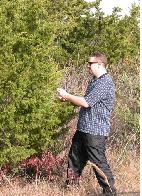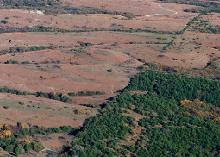Ecological and biogeochemical consequences of ongoing changes in landcover in the grasslands
An important aspect of global change in grasslands is an increase in the cover of woody plants, which has been reported in grasslands and savannas worldwide. Although the increase in shrub and tree cover has been widely documented, little is known regarding the ecological consequences of this land cover change. NASA Kansas Space Grant (KSG) fund are supporting the research activities of a Ph.D. student (Duncan McKinley, left photo) working with Dr. Blair in the Division of Biology at K-State.  Their research is examining changes in ecological processes, especially the cycling of essential nutrients and storage of carbon, in areas of the northern Flint Hills that have undergone recent (ca. last 40-60 years) conversion from tallgrass prairies to woodlands dominated by eastern red cedar (Juniperus virginiana, right photo). This research is part of a larger NASA-funded Land Cover/Land Use Change (LCLUC) project
Their research is examining changes in ecological processes, especially the cycling of essential nutrients and storage of carbon, in areas of the northern Flint Hills that have undergone recent (ca. last 40-60 years) conversion from tallgrass prairies to woodlands dominated by eastern red cedar (Juniperus virginiana, right photo). This research is part of a larger NASA-funded Land Cover/Land Use Change (LCLUC) project  to (1) use remotely sensed data to determine rates and patterns of woody encroachment over space and time in the Great Plains, (2) assess the ecosystem and biogeochemical consequences of this change in land cover, and (3) develop a predictive model to forecast future rates of woody encroachment.
to (1) use remotely sensed data to determine rates and patterns of woody encroachment over space and time in the Great Plains, (2) assess the ecosystem and biogeochemical consequences of this change in land cover, and (3) develop a predictive model to forecast future rates of woody encroachment.
 Home
Home